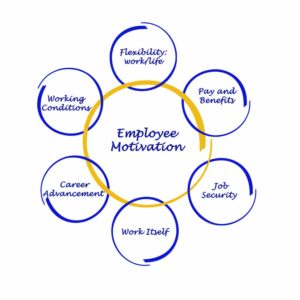It’s Not All About the Money: 3 Ways to Motivate Employees

Have you noticed how oftentimes, managers believe that money is the best way to motivate their employees? They assume a well-paid employee will be a productive employee. But, in fact, evidence points to money being among the worst motivators. The Harvard Business Review recently reviewed the existing research on the subject and determined that “there is little evidence to show that money motivates us, and a great deal of evidence to suggest that it actually demotivates us.”
 Specifically, the HBR cited the study by Tim Judge and his colleagues in which it was found that there is a less than 2% correlation between pay and job satisfaction. Additionally, Gallup’s 2013 State of the American Workplace study found that only 30% of the American workforce is motivated, and there is no significant difference in engagement between pay levels.
Specifically, the HBR cited the study by Tim Judge and his colleagues in which it was found that there is a less than 2% correlation between pay and job satisfaction. Additionally, Gallup’s 2013 State of the American Workplace study found that only 30% of the American workforce is motivated, and there is no significant difference in engagement between pay levels.
So how can you motivate your employees? The answer lies in the difference between intrinsic and extrinsic motivations.
Employees who work because they love their job (intrinsic motivation) are three times as engaged as employees who work for money or rewards (extrinsic motivations). So rather than focusing only on pay raises and bonuses, managers should work to develop their employees’ connection to and satisfaction with their work. Here are 3 ways to motivate employees:
Foster a Supportive Work Environment
Employees are more likely to be motivated if you provide them with a workplace culture that supports their efforts. As a leader in your business, this positive environment starts with you. 67% of employees are “very motivated” or “extremely motivated” by receiving praise and commendation from their immediate manager. Additionally, 63% are very motivated by receiving attention from their leaders.
This supportive environment can also be fostered through small, close-knit teams. The aforementioned Gallup study found that smaller teams (five to nine employees) had higher levels of engagement than teams of 10 or more. Smaller teams allow each employee to have a voice and a role within the group, and employees are more likely to feel like their work is validated.
Allow For Growth and Flexibility
Employees are also more likely to be engaged if they feel like they have room to grow. This growth doesn’t have to be directly tied to financial benefits; employees often just want the opportunity to develop as workers and as people. According to the aforementioned engagement study, 62% of employees are very motivated by the prospect of leading projects or task forces.
Another way to allow employees to develop is to give them the flexibility to work when and where they want. The aforementioned Gallup study found that employees are more engaged when they are given the chance to work from home or a place of their choosing. However, this doesn’t mean that all employees should work remotely all the time. The study found that employees who work remotely only part of the time (less than 20%) were the most engaged (35%), perhaps because they get both the flexibility of remote work and the camaraderie of office work.
Make Work into a Game
Gamification, the business practice of using game mechanics to boost user engagement, has proven very successful to inspiring employee engagement. A recent Forbes article describes how the consulting agency Deloitte was struggling to encourage their employees to complete a leadership training course. So, they implemented a series of game elements, including badges and status symbols. Afterwards, certification time was reduced by 50 percent.
So how can you turn your employees’ work into a game?
One way is to track each employee’s profitability over time. First track employee time for each project and the costs of each project, and then you can determine per-employee profitability. Each quarter your employees can compete against their own former productivity score. Much like a runner trying to beat her previous time, your employees will be more engaged in their work and more motivated to improve their productivity.
The motivation of your workforce is directly tied to the success of your company. And so instead of relying on salaries and bonuses to drive employee engagement, make sure your company is a place where your employees actually want to work.
Your employees and your business will thank you for it.
Category: Business Growth & Strategy Communication & Alignment Leadership
Tags:

